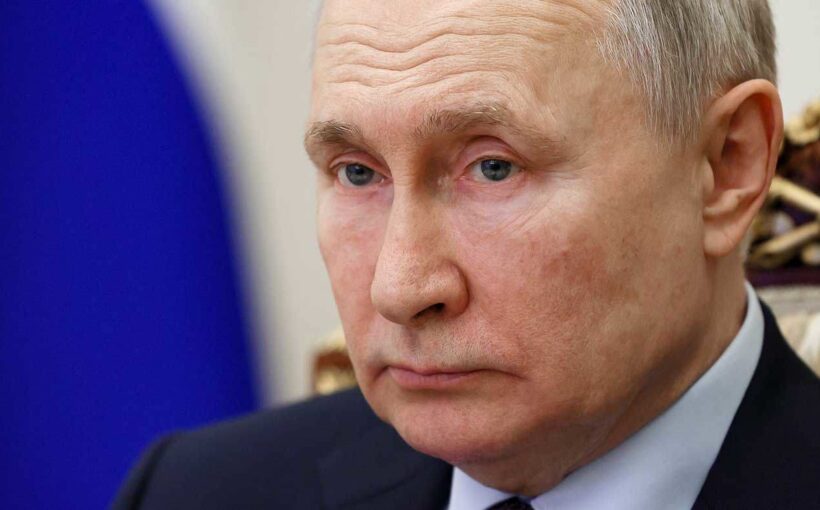A man under arrest by Russian internal security forces was seen confessing to a “crime”, in a video posted on January 2. He had been apprehended after allegedly posting a video on social media that purportedly showed air defences near the Russian city of Belgorod. This city, on the border with Ukraine, was the target of Ukrainian missile attacks on the same day.
What was notable, though, about this confessional was that the man was flanked by two internal security officers who had the word Smersh emblazoned on the backs of their jackets.
Many people in the west remember Smersh from Ian Fleming’s early James Bond novels (and early films). It was the shadowy Soviet spy agency bent on eliminating the fictional British agent.
But there was nothing fictitious about Smersh itself. It was a real counterintelligence agency set up in Joseph Stalin’s Soviet Union during the second world war.
Indeed, the name Smersh (a blend of Russian words Smert’ Shpionam which translates into English as “death to spies”), was supposedly coined by Stalin himself. The fact that Smersh – with its alarming moniker – has reappeared may be seen as a further indication of the increasing clampdown on all forms of internal dissent in Russia.
Smersh and German spies
Smersh was originally set up to focus on German spies operating within the Soviet Union during the second world war. Prior to its establishment in April 1943, counterintelligence operations were within the purview of the NKVD (Osobye Otdely Narodnogo Kommissariata Vnutrennikh Del).
Thereafter, the counterintelligence reins were assumed by the 3rd Main Directorate for Counterintelligence of the People’s Commissariat of Defence (GUKR-NKO). This is the body that Stalin renamed Smersh. In Russian, the term “death to spies” is a declaration, not a description. It probably demands an exclamation mark and is a name that is inevitably designed to invoke fear.
Smersh’s main role was not just to root out spies, but also to monitor the patriotism of members of the Red Army and the overall civilian population. In this capacity, Smersh did invoke a significant degree of fear across the country. Declassified archives from the Federal Security Service (Federal’naya Sluzhba Bezopasnosti or FSB – Russia’s current internal intelligence agency) shed light on Smersh’s activities.
Apparently, it was responsible for the identification (and inevitable death) of approximately 30,000 German “spies” within the Red Army, and arrested at least 594,000 more Soviet soldiers. Just how many of these people were actual “spies” is very much open to doubt.
It was also a “vitally important instrument of political repression” among the civilian population near the front. Indeed, it was seen to be more effective as an instrument of political repression than as a counterespionage service.
Smersh phased out?
Smersh was disbanded in 1946. It had fulfilled its primary purpose once the war was over. But it now seems that the demands of the current war in Ukraine has led to its return.
In March 2023, Sergey Aksyonov, the Moscow-installed political leader of occupied Crimea, had proposed the creation of a counterintelligence organisation reminiscent of Smersh. This was due to his concern about a purported “fifth column” operating within Crimea.
Aksyonov’s proposal was implemented on December 4 2023, when Lt Gen Andrei Gurulev, from the Russian Duma’s committee on defence, announced the revival of Smersh in the “new territories” – that is, in those areas of Ukraine now controlled by Russian forces.
The new Smersh, said Gurulev, would be an agency that will “work in approximately the same way in the new territories as did the old Smersh in the Soviet Union”.
While the actual affiliation of the officers seen in the “confessional” video noted above wearing the Smersh jackets remains uncertain, the fact that the name itself has reemerged is itself telling. There must be a significant problem to solve.
And, in the occupied territories and in those Russian regions close to Ukraine, there are increasing reports of behind-the-lines operations by forces, groups or individuals working for Kyiv. For example, in November 2023, numerous Russian military media outlets reported instances of Ukrainian sabotage activities and operations by reconnaissance groups (known as DRGs – diversionno-razvedyvatel’naya gruppa).
The challenges to the internal security forces in Russia extend well beyond the regions close to Ukraine (such as Belgorod). There was also, in December, a reported attack on a railway line in Siberia (presumably in an attempt to interdict Russian military supply lines).
The revival of the name Smersh – even if no new agency has actually been created – is patently a form of messaging. It is designed, it must be assumed, to invoke fear in the Russian people.
The targets will not just be potential saboteurs, but also, and perhaps more pertinently, the entire Russian people. The overall message is: “Do not do anything that undermines the country’s ‘special military operation’ in Ukraine; because if you do the consequences could be severe.” It could lead to smert – death.
And, while “crimes” could include posting sensitive videos, they will also include any criticism of the war and of the government that may be interpreted as subversive.
The resurrection of the name Smersh is clearly the reaction of an increasingly oppressive state. Russian authorities, it can only be assumed, want to invoke fear again. This does not bode well for the Russian people.
![]()
Marina Miron received funding from the British Academy.
Rod Thornton does not work for, consult, own shares in or receive funding from any company or organization that would benefit from this article, and has disclosed no relevant affiliations beyond their academic appointment.



